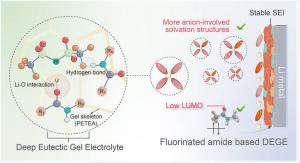New electrolyte design extends lithium metal battery life beyond 9,000 hours
GA, UNITED STATES, October 21, 2025 /EINPresswire.com/ -- Lithium metal batteries (LMBs) hold the potential to power the next era of energy storage with unmatched energy density, but their progress is hindered by instability and safety concerns. A new study introduces fluorinated deep eutectic gel electrolytes (DEGEs) that address these challenges by combining high ionic conductivity, superior interfacial stability, and nonflammability. By precisely tuning the molecular structure of amides, researchers achieved a gel electrolyte that forms a robust protective layer on lithium surfaces, dramatically extending cycling life. With stable operation demonstrated in both laboratory cells and pouch batteries, this design paves the way for safe and sustainable LMBs that could revolutionize portable electronics, electric vehicles, and large-scale energy storage.
Lithium metal batteries (LMBs) are considered a cornerstone for future energy storage because of their high theoretical capacity. Yet, traditional liquid electrolytes pose severe risks, including leakage, combustion, and dendritic lithium growth, which compromise both safety and performance. Recent advances in deep eutectic gel electrolytes (DEGEs) have shown promise, thanks to their high ionic conductivity, wide electrochemical window, and inherent thermal stability. However, persistent issues with the fragile solid electrolyte interphase (SEI) continue to limit their practicality. Ensuring a stable, uniform SEI while maintaining efficiency remains a critical challenge. Due to these problems, there is a pressing need to conduct in-depth research on new electrolyte designs that combine safety with durability.
Researchers from Nankai University and collaborators report a major advance in battery technology with the development of fluorinated DEGEs. The work, published (DOI: 10.1021/jacs.5c08642) on August 21, 2025, in the Journal of the American Chemical Society, demonstrates that careful fluorination of amide-based molecules results in a highly stable electrolyte system. By lowering the energy barrier for lithium-ion desolvation and enabling a solvent–anion cooperative mechanism, the new DEGE supports LMBs that can operate safely for thousands of hours, withstanding both high current densities and elevated temperatures.
The team designed a series of fluorinated amides to serve as the foundation for DEGEs, guided by a bidirectional screening criterion that integrates molecular orbital energy levels and ion desolvation barriers. Among the candidates, 2,2,2-trifluoro-N-methylacetamide (C=Oα3F) stood out for its uniquely low lowest unoccupied molecular orbital (LUMO) and minimal Li+ desolvation barrier. This dual effect promotes rapid formation of a compact SEI enriched with LiF and Li3N, resulting in a mechanically strong protective interface. Atomic force microscopy confirmed the SEI's high modulus (6.9 GPa), while spectroscopic analyses revealed uniform distribution of inorganic components critical for dendrite suppression.
Electrochemical tests showed remarkable results: symmetric Li||Li cells cycled stably for over 9,000 hours, while Li||LiFePO4 cells retained 81.7% capacity after 2,500 cycles. Even under elevated temperatures (80 °C), the electrolyte maintained stability for 300 cycles, and pouch cells exhibited excellent safety in nail penetration and thermal runaway tests. The gel form also prevented leakage and minimized thermal expansion, enhancing operational safety. Collectively, these findings highlight the synergistic role of fluorination and gel confinement in overcoming the long-standing limitations of LMBs.
“Our study demonstrates how precise molecular design can simultaneously tackle multiple challenges in lithium metal battery development,” said Professor Tianfei Liu, a senior author of the work. “By introducing fluorinated groups into DEGEs, we achieved not only enhanced interfacial stability but also markedly improved cycling durability and thermal safety. These results present a promising pathway for scaling up LMBs in practical devices. This strategy bridges fundamental chemistry with real-world performance requirements, offering a blueprint for the next generation of high-performance electrolyte design,” added Professor Kai Zhang, also a senior author.
The development of fluorinated DEGEs marks a crucial step toward the commercialization of LMBs. Their ability to sustain long-term cycling, suppress dendrite formation, and withstand high temperatures directly addresses the major hurdles in deploying LMBs for electric vehicles and grid-scale storage. Moreover, the demonstrated safety in large pouch cells underscores their potential for real-world applications. This innovation could accelerate the shift to cleaner energy technologies by enabling batteries with higher energy density, longer life spans, and safer operation, ultimately contributing to sustainable transportation and renewable energy integration worldwide.
DOI
10.1021/jacs.5c08642
Original Source URL
https://doi.org/10.1021/jacs.5c08642
Funding information
This work was supported by the National Key Research and Development Program of China (2025YFF1502100), the National Natural Science Foundation of China (K.Z., Grants 22479080 and 92372203; T.L., Grants 22171141 and 22193014; J.C., Grants 22121005, 22393900, and 92372001), the Science and Technology Plans of Tianjin (K.Z., Grants 23JCYBJC00170 and 24JCJQJC00220; J.C., Grant 24ZXZSSS00390), and the Fundamental Research Funds for the Central Universities, Nankai University (K.Z., Grant 020-63253167; T.L. Grant 63233022).
Lucy Wang
BioDesign Research
email us here
Legal Disclaimer:
EIN Presswire provides this news content "as is" without warranty of any kind. We do not accept any responsibility or liability for the accuracy, content, images, videos, licenses, completeness, legality, or reliability of the information contained in this article. If you have any complaints or copyright issues related to this article, kindly contact the author above.

